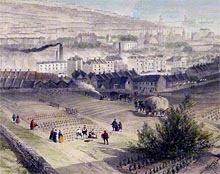About
MyHouseMyStreet
 The project provides local people with the means to discover who lived in their homes in the past and a historical resource for others with an interest in history.
The project provides local people with the means to discover who lived in their homes in the past and a historical resource for others with an interest in history.
The project was conceived by staff and volunteers at The Regency Town House Heritage Centre in the City of Brighton & Hove and was made with support from the Heritage Lottery Fund.
Project goals
MyHouseMyStreet sets out to achieve two principal objectives:
-
Make a database of data from census returns and street directories and compile this to enable users to view the occupancy history of local properties.
-
Write detailed street histories using primary and secondary source materials and make these available to users.
The project outputs are aimed at local residents who want to learn about the past occupants of their home and the history of their street, and academics and local historians studying trends such as employment patterns, population statistics and migration.
Background
MyHouseMyStreet grew out of Brighton & Hove Open Door, the city's contribution to the national Heritage Open Days event.
The Regency Town House had co-ordinated all Brighton & Hove Open Door events since it began in 1994. To enlarge our own contribution in 2008, we launched a new kind of project, The Foundry Street Event.
Foundry Street is typical of the 19th century streets in Brighton's North Laine area. Saved from slum clearance in the 1950s, it now provides homes and workplaces for a variety of people. While it may appear of little interest when compared with Brighton's more celebrated areas, we saw this as an opportunity to show that an ordinary street can have an interesting history and be worthy of care and respect.
The Foundry Street Event 2008 used information gathered principally from street directories and census records to show the street's history and list the past occupants of houses. By focusing on history at such an intimate level we aimed to encourage an interest in local heritage and, ultimately, to motivate people to take part in decisions that impact on Brighton & Hove's architectural legacy.
The event generated a lot of interest amongst residents and visitors, encouraged neighbours to get to know one another, generated a sense of pride-in-place and resulted in requests for similar events in other streets. We responded by planning further 'Street Events' for the following year and by re-naming the event 'MyHouseMyStreet' to convey the essence of what we were trying to achieve.
MyHouseMyStreet 2009 expended to four locations: Foundry Street, Gloucester Road, Kensington Place and Pelham Square, all in North Laine. We concentrated on this area due to its rich history and because it typifies the development of Brighton & Hove from rural economy, through the industrial revolution to modern times.
It became clear that much of the success of MyHouseMyStreet was due to more people being involved in the research. This convinced us that researching and documenting a street is just as valuable as exhibiting the results and that that we should try to encourage more people to do it. It was also obvious that the street histories should be available year-round and not just during periodic exhibitions.
The answer was to publish MyHouseMyStreet content on the web, with three main aims:
-
To promote historical research through training and participation
-
To make the results of this research available online
-
To provide material for Brighton & Hove Open Door events
To see what would be involved a prototype website was made. We quickly realized that to deliver the final product was going to require more than volunteered help alone, so an application was made to the Heritage Lottery Fund. This was successful and in September 2010 work began to make this website and to stage a range of related events.
